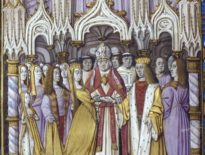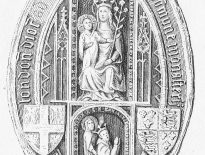Katherine or 'Kat' Ashley (Astley, née Champernowne) is the purported daughter of Sir Phillip Champernowne, a wealthy landowner in Devon, and his wife, Katherine, daughter of Sir Edmund Carew. Although we do not know much regarding her early years, we do know that Kat received an education unlike that of her contemporary aristocratic women. For aristocratic women, their education centred on what would render them desirable for marriage and as such, learned dancing, sewing, embroidery and music in the place of reading and writing. As such, may aristocratic women were barely literate at all. Kat, however, received an education that was equal to that of a man, learning classical scholarship and developing an interest in humanism, her father being unusually committed to the education of his daughters. Kat’s humanist leanings and interests caught the eye of Thomas Cromwell, who suggested that she be appointed to the household of Princess Elizabeth. It is this appointment which would shape her life, and mark her as a historical figure worthy of note.
In the autumn of 1536, mere months after the death of Anne Boleyn, Kat was appointed to the household of Princess Elizabeth. It is believed that she was in her late twenties or early thirties at the time of this appointment. Following the departure of Elizabeth’s governess, Lady Bryan, to the household of Prince Edward, Kat was appointed as governess to the three-year-old princess. Kat’s education provided intellectual stimulation for the young Elizabeth who was a bright and precocious child, and Elizabeth’s intellectual prowess is a positive reflection of Kat’s role as educator as she instilled a love of learning in the young girl which would continue throughout her life. Kat’s lively and warm disposition also provided Elizabeth with a companionship that she surely craved. Kat’s warmth and affection for Elizabeth surpassed that normally expected from governesses as she flew in the face of tradition by creating a strong bond with her young charge which would last a lifetime. Kat, therefore, became an important and influential figure for Elizabeth, with some arguing that she became the mother that Elizabeth never had. Around the year 1545, Kat married John Ashley, a courtier, and her name is remembered in history as ‘Kat Ashley.’
Although an intelligent and responsible woman, Kat lacked some of the common sense that was needed in a woman of her position, evidenced by her behaviour in later years. Kat’s involvement in the Seymour scandal, for example, illustrates an immature streak which proved problematic. Upon the death of Henry VIII, Elizabeth went to live with Katherine Parr and her new husband Thomas Seymour. During Elizabeth’s stay here, Thomas Seymour began paying court to Elizabeth, and Kat stated that one morning Seymour came into Elizabeth’s bedchamber to bid her good morning, and attempted to kiss her. Far from being aghast, however, Kat encouraged these flirtations and in her own accounts details that Seymour would come to her (Elizabeth’s) chamber and “strike hir upon the Bak or the Buttocks.”1 Finally, however, Kat came to her senses and reported the incident and flirtations to Katherine Parr. Her reluctance to do so before indicates a naivety and immaturity to her character, some say born out of personal infatuation for Seymour. These inherent flaws in her character saw Kat blunder into one scandal after another.
Following the death of Katherine Parr, Kat strongly pursued a match between Elizabeth and Thomas Seymour, and encouraged Elizabeth, convincing her young charge of the benefits of this match. However, a royal marriage could not be sanctioned without the consent of the sovereign and council. When the council learned of the scheme, Thomas Seymour and Kat were accused of treason in the January of 1549, and placed in the Tower of London. Kat was reluctant to confess and as punishment was moved to the darkest cells of the Tower, but still would not implicate Elizabeth in any wrongdoing. Eventually, however, Kat confessed and detailed the nature of Seymour’s affections for Elizabeth, recounting the sordid nature of his attentions to the young princess. Kat was saved by Elizabeth, who acknowledged that she spoke with her governess of Thomas Seymour, but had told her that nothing could be done without the council’s consent. Furthermore, Elizabeth wrote to the council pleading that Kat be released from the Tower of London; a place which undoubtedly resonated negatively with the young princess. Unable to charge Kat with treason, the council released Kat from the Tower and subsequently removed her from Elizabeth’s household, something which was heart-wrenching for them both. Eventually, some two years later, Kat was reinstalled in Elizabeth’s household. All seeming well, Kat remained a constant companion to Elizabeth during the remainder of Edward’s reign, however, there was more trouble yet to come for the governess.
Upon the accession of Mary I, Elizabeth’s position became precarious. Throughout the reign of Mary I, Elizabeth was a figurehead for Protestant rebellions, and a plot in 1554 is an example of such a rebellion. Mary was convinced, whether by her own suspicions or that of her councillors, that Elizabeth was involved and as such had her arrested and sent to the Tower of London. Due to her closeness with Elizabeth, Kat was also sent to the Tower, something which can only be described as guilt by association. Unlike her first stay in the Tower, Kat was not the focal point of treasonous accusations herself, but faced the brunt of them nonetheless and stood by her mistress. Although proved innocent alongside Elizabeth and released, Kat was placed into custody and only restored to Elizabeth’s household in April 1555. Later that year, however, another plot was uncovered and Mary was determined to implicate her sister. As such, she ordered a search of Somerset house and found in Kat’s possession books, pamphlets and papers which were anti-Catholic and anti-Mary. Once again, for the third time, Kat Ashley was arrested and placed back in the Tower. Kat’s defence this time was that she knew nothing of the plot until the leaders had been arrested. However, her admission of even knowing about any plot was enough in those dangerous times to warrant execution. As the year wore on, Kat languished in the Tower until in October she was miraculously set free, but this came with a price; Mary dictated that she was never to see Elizabeth again.
Following the death of Mary I and the accession of Elizabeth I, Kat was once more restored to her rightful place by Elizabeth’s side and was rewarded a place of honour at her coronation, witnessing her private transition into Queen. Upon her accession, Elizabeth awarded Kat the place of Chief Gentlewoman of the Privy Chamber, the most prestigious position in the royal household, giving Kat continuous access to Elizabeth as she attended her both night and day. Kat advised and influenced Elizabeth in both private and public matters in the earl part of her reign, with one ambassador stating that Kat had “such influence with the queen that she seemed, as it were, patroness of all England.”2 Although she enjoyed the highest prestige and influence with Elizabeth, this did not stop her from getting into yet more trouble. During Elizabeth’s reign, Kat encouraged her mistress to marry multiple times and meddled in the courtship of Elizabeth and Erik XIV of Sweden. Kat worked behind the scenes attempting to get the match to come to pass, going as far as writing to the Swedish Chancellor in secret. When this was found out, Kat was placed under house arrest. However, unlike her prior arrests, Kat was released within a month and restored to her position at Elizabeth’s side.
Kat Ashley remained at Elizabeth’s side until 1565, when she died on the 18th of July, an event which sent Elizabeth into a period of inconsolable grief.
Kat’s life, spent at the side of Elizabeth I, is a testament to loyalty, devotion and the impregnable friendship and love that these two women shared.
By Georgia Whitehead
Georgia has just finished her masters in Classics at the University of Edinburgh. Academically, Georgia is interested in early Christianity, with her master's thesis focusing on "The Male Gaze and Self-Representation in Female Christian Narratives". In addition to her interest in ancient history, she has always been an avid lover of the Tudor era, drawn to the magnificence of the Tudor courts and the larger than life characters. She is particularly interested in The Reformation, Christianity and the shifting sands of ecclesiastical politics in this period and also has a keen interest in the lives of Tudor women. It is Georgia's ambition to become a writer, perhaps publishing her own Tudor novel one day.
Notes
- Haynes (1740), 99.
- CSP Rome, I, 105.
Bibliography
- Haynes. S (1740) ‘A collection of State Papers… Left by William Cecil Lord Burghley, now remaining at Hatfied House’ London
- Rigg J.M (1916) ‘Calendar of State Papers relating to English affairs in the Vatican Archices, Vol 1 1558-1571’ London.
- Borman, Tracy (2009) ‘Elizabeth’s Women, The Hidden Story of the Virgin Queen’, Vintage Books, London.
- Whitelock. A. (2014) ‘Elizabeth’s Bedfellow; An Intimate History of the Queens Court.’ Bloomsbury. London.
Online sources
- MAZZOLA, E., 2010. Schooling Shrews and Grooming Queens in the Tudor Classroom. Critical Survey, 22(1), pp. 1-25,99.
- Oxford Dictionary of National Biography.
https://www.oxforddnb.com/view/10.1093/ref:odnb/9780198614128.001.0001/odnb-9780198614128-e-68016?rskey=cFzKvq&result=410#odnb-9780198614128-e-68016-div1-d463777e510



Leave a Reply